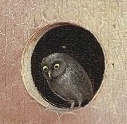








R. E. Hemphill, The Personality and Problem of Hieronymus Bosch, Proceedings of the Royal Society of Medicine, 1965 February; 58(2): p137–144.
Hemphill surveys Bosch's work from the perspective of a psychiatrist. His views are tinged with the idea that Bosch was reflecting alchemy and witchcraft as deep concerns of his age.
"We can surmise that with his exceptional visualizing powers, objects as well as ideas which would have evoked powerful associations in the unconscious, produced visual images or hallucinations that he perceived and accepted as real, and thereby altered the total original perception. This is common in psychiatric illness, and some patients are unable to resist it, but they seldom have the ability to concentrate and organize their personal visions and hallucinations into a significant work of art."
"Some inference can now be made about the personality and nature of Bosch. He was withdrawn and inward-looking, unaware of the warmth of love, unmoved by human pleasures and disappointments, unconcerned with children. He was introspective, engrossed with mystical philosophy and magic, he was almost certainly an alchemist, he believed implicitly in witchcraft, and he was a doubtful Christian. He was a schizoid personality. Deliberately or compulsively he painted documentaries of the supernatural world and the Devil's campaign."This seems a bit of a stretch, even for a psychoanalyst !
Erika Fromm. The Manifest and Latent Content of Two Paintings by Hieronymus Bosch: A Contribution to the Study of Creativity. American Imago. A Pyschoanalytic Journal for Culture, Science and the Arts. Vol. 26, No. 2. Summer 1969. New York.
Fromm, a Freudian analyst makes her perspective quite clear in her introduction.
"To my mind, there is little doubt that the middle panel [of the Garden of Earthly Delights] expresses conscious and preconscious heterosexual yearnings, and polymorphous perverse ideation in conflict with unconscious super-ego and ego reactions."She then goes on in her first section to do a Holt scoring of the painting. This was a technique devised by Holt of assigning values to various responses of patients to Rorschach inkblots. She applies this to the painting ! This Holt apparatus, has eleven content categories, six being of libidinal content (oral, anal, sexual, exhibitionist-voyeuristic, homosexual and miscellaneous) and five being of aggressive content actively-aggressive, being passively aggressed against, potential-aggressor, potential object of aggression and results of aggression. Thus applying this technique to the lovers in the transparent flower form on the lake, this is given a score of Level 1 (L 1 E-V) [4], and the man looking down the glass tube in the lower part of this image is given a voyeuristic score of (L 2 E-V) [1]. Somehow she combines all this Holt analyses together and comes to the conclusion.
When one studies these two beautiful, haunting, enigmatic paintings, one recognises in them the tragedy of a homosexual, and perhaps also of an impotent man who dreamt and fantasised endlessly about all kinds of sexual pleasures: but whose punitive Super-Ego, severe castration fear, and sado-masochistic pre-genital fixation most likely prevented him from having normal, lusty sexual relationships.This article surely must be read by anyone attempting to produce a new interpretation of Bosch, as an object lesson in how easy it is to project ones own perspective onto poor old Bosch. When I first read her article I burst out laughing at the nonsense of applying the Holt score system to it. Fromm must have been blind to this absurdity. At least her article gives us a good laugh.
The Jungians did not leave Hieronymus Bosch alone. The president of the Psychological Club of Zürich, Alfred Ribi, provided the Jungian view.
Alfred Ribi. Die Dämonen des Hieronymus Bosch. Versuch einer Deutung. Küsnacht, 1990.
"A painter like Hieronymus Bosch can never be understood only as personal material, but his unconscious statements are an analysis of his and our time."Ribi adopts the usual Jungian approach seeing such things as unconscious eruptions, stealing away from Bosch all his hard work and thoughtful struggle to work out the placement and form of his images.






